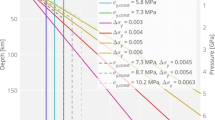Abstract
Numerical simulation shows that the hot plumes can be formed by the self-accelerated process if local thermal perturbation is present. Since the local thermal perturbation may exist extensively near the CMB and the transition zone around 670 km, the number of the hot plumes should be great. The cold plume seems to be originated by the subduction slabs. Because the subduction belts distribute extensively on the Earth’s surface, the number of the cold plume should be also great. However, the observed number of the superplumes is much less than the supposed ones. A simple 2D model of whole mantle convection is designed to investigate the interaction between plumes and thermal anomalies. The hot thermal anomalies (HTA) are imposed at CMB and a depth of about 670 km discontinuity, corresponding to two plausible locations of the hot plumes origination. And, the cold thermal anomalies (CTA) are imposed near the surface and 670 km discontinuity, corresponding to the subducted slabs and possible accumulation of slabs at 670 km discontinuity. The numerical results show that the fixed HTA does not originate a new plume. It draws the hot plume to move towards itself and stabilizes the plume at its own position. The imposed free HTA moves towards the hot plume, and finally merge with the plume. The situation for the CTA is similar to that for the hot one. From the numerical results, we can reach the following conclusions. It is very difficult for the HTA/CTA to originate a new hot/cold plume in a convective flow field. The boundary instability is suppressed by the developed plumes. Instead of originating new hot/cold plumes, the HTA/CTA interact with the plumes to form huge superplumes. This might be one reason for the question, why the number of the superplumes is so limited.
Similar content being viewed by others
References
Allégre, C.J. and Turcotte, D.L., 1985, Geodynamic mixing in the mesosphere boundary layer and the origin of oceanic islands. Geophysical Research Letters, 12, 207–210.
Anderson, D.L., 1975, Chemical plumes in the mantle. Geological Society of America Bulletin, 86, 1593–1600.
Batchelor, G.K., 1967, An Introduction to Fluid Dynamics. Cambridge University Press, London and New York, 164 p.
Bercovici, D., Schubert, G., Glatzmaier, G.A., 1989. Three dimensional spherical models of convection in the Earths mantle, Science, 244, 950–955.
Burke, P.J. and Wilson, J.T., 1976, Hotspots on the earths surface. Scientific American, 235, 46–57.
Chase, C.G., 1979, Subduction, the geoid and lower mantle convection. Nature, 282, 464–468.
Clark, S.P., 1957, Radioactive transfer in the earths mantle: Transaction of the American Geophysical Union, EOS, 38, 931–938.
Crough, S.T. and Jurdy, D.M., 1980, Subducted lithosphere, hot spots, and the geoid. Earth Planetary Science Letters, 48, 15–22.
Davies, G.F. and Richards, M., 1992, Mantle convection. Journal of Geology, 100, 151–206.
Dziewonski, A.M., 1984, Mapping the lower mantle: Determination of the lateral heterogenity in P velocity up to degree and order 6. Journal of Geophysical Research, 89, 6929–5952.
Dziewonski, A.M. and Woodhouse, J., 1987, Global images of the Earths interior, Science, 236, 37–48.
Foucha, M.J., Fischerb, K.M., Wysession, M.E., 2001, Lowermost mantle anisotropy beneath the Pacific: Imaging the source of the Hawaiian plume, Earth and Planetary Science Letters, 190, 167–180.
Fukao, Y., 1992, Seismic tomogram of the Earths mantle: Geodynamic implications. Science, 258, 625–630.
Fukao, Y., Maruyama, S., Obayashi, M. and Inoue, H., 1994. Geological implication of the whole mantle P-wave tomography Journal Geological Society of Japan, 100, 4–23.
Honda, S. and Yuen, D.A., 1990, Mantle convection with moving heat-source anomalies: geophysical and geochemical implications, Earth and Planetary Science Letters, 96, 349–366.
Jin, X., Han, X and Ehara, S., 2000, Thermal structure and energy in North-Eastern part, China. Geosciences Journal, 4, 105–108.
Lee, C.K. and Han, U., 2001, Estimation of borehole temperature disterbed by drilling. Geosciences Journal, 5, 313–318.
Loper, D.E., 1991, Mantle plumes, Tectonophysics, 187, 373–384.
Loper, D.E. and Stacey, F.D., 1983, The dynamical and thermal structure of deep mantle plume. Physics of Earth Planetary Interior, 33, 304–317.
Malamud, B., Turcotte, D.L., 1999, How many plumes are there? Earth and Planetary Science Letters, 174, 113–124.
Maruyama, S., 1994, Plume tectonics. Journal Geological Society of Japan, 100, 24–49.
Morgan, W.J., 1971, Convection plumes in the lower mantle. Nature, 230, 42–43.
Morgan, W.J., 1972, Plate motions and deep mantle-convection. Geological Society of America Memoir, 132, 7–22.
Olson, P., Schubert, G. and Anderson, C., 1987, Plume formation in the D-layer and the roughness of the core-mantle boundary. Nature, 327, 409–413.
Su, W., Woodward, R.L. and Dziewonski, A.M., 1992, Deep origin of the midoceanic ridge seismic velocity anomalies. Nature, 360, 149–152.
Su, W., Woodward, R.L. and Dziewonski, A.M., 1994, Degree-12 model of shear velocity heterogeneity in the mantle. Journal of Geophysical Research, 99, 11231–11250
Tanimoto, T., 1990, Predominance of large-scale heterogeneity and shift of velocity anomalies between the upper and lower mantle. Journal of Physics of Earth, 38, 493–509.
Turcotte, D.L., Torrance, K.E. and Hsui, A.T., 1973, Convection in the Earths mantle. In: Bolt, B.A. (ed.), Methods of Computational Physics. Academic Press, New York, N.Y., 13, p. 431–453.
Wilson, J.T., 1963, A possible origin of the Hawaiian islands. Canadian Journal of Physics, 41, 863–870.
Woodhouse, J. and Dziewonski, A.M., 1984, Mapping the lower mantle: Three dimensional modeling of earth structure by inversion of seismic waveforms, Journal of Geophysical Research, 89, 5953–5986.
Ying, J., Nataf, H., 1998, Detection of mantle plumes in the lower mantle by diffraction tomography: Hawaii Earth and Planetary Science Letters, 159, 99–115.
Yuen, D.A. and Peltier, W.R., 1980, Mantle plumes and the thermal stability of the D layer. Geophysical Research Letters, 7, 625–628.
Zhang, Y.S. and Tanimoto, T., 1993, High resolution global upper mantle structure: Plate tectonics. Journal of Geophysical Research, 98, 9793–9823.
Author information
Authors and Affiliations
Corresponding author
Rights and permissions
About this article
Cite this article
Xiong, X., Han, U., Fu, R. et al. Why is the number of superplumes so limited?. Geosci J 6, 79–90 (2002). https://doi.org/10.1007/BF03028279
Received:
Accepted:
Issue Date:
DOI: https://doi.org/10.1007/BF03028279



